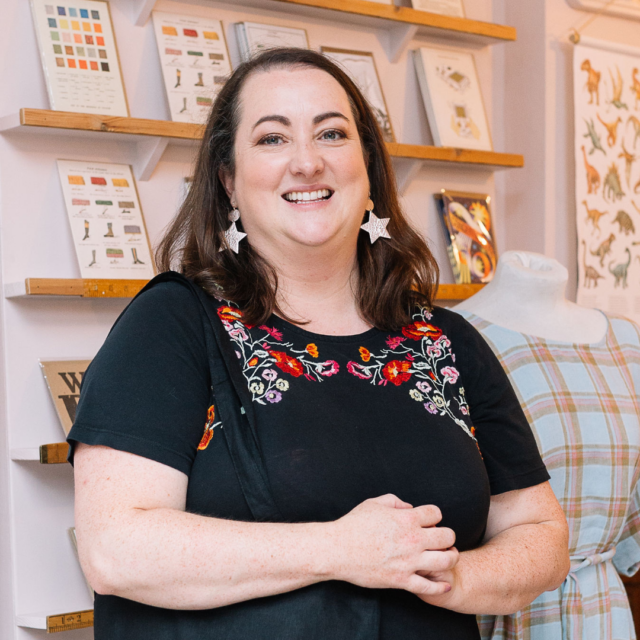Your Stock Management Questions Answered
Catherine Erdly: Welcome to the resilient retail game plan. Hi, I’m your host, Catherine, as well as the founder of the resilient retail club, which is my membership group and mastermind for product businesses. Go check it out at resilientretailclub.Com.
So today I am wrapping up my mini series on stock management by answering your questions.
And if you haven’t heard the rest of the episodes, then do please go check them out. So I have been covering my three golden rules of stock management. That is episodes number 193, 194, and 195 on the podcast. The episodes from the last three weeks. So do please go ahead and check those out and listen. If you want a bit more background or stock management is a topic that you’re not as familiar with.
Welcome to the Resilient Retail Game Plan, a podcast for anyone wanting to start, grow or scale a profitable creative product business with me, Catherine Erdly. The Resilient Retail Game Plan is a podcast dedicated to one thing, breaking down the concepts and tools that I’ve gathered from 20 years in the retail industry and showing you how you can use them in your business.
This is the real nuts and bolts of running a successful product business, broken down in an easy, accessible way. This is not a podcast about learning how to make your business look good. It’s the tools and techniques that will make you and your business feel good.
Confidently plan, launch and manage your products and feel in control of your sales numbers and cashflow to help you build a resilient retail business.
If you have questions about stock management that are not answered here reach out!
Catherine Erdly: What I wanted to do today is jump in with four questions that I’ve been asked and they’re all around the theme of stock management. If you’ve got a question about stock management that hasn’t been answered by today’s podcast, and you’d like to get my input. If you’re a member of the resilient retail club, you get to ask me whatever questions you like whenever you like. So do go check out the membership under resilientretailclub.com. And also if you want to drop me a note on Instagram, tell me what question you didn’t get answered. I’d be really curious to know.
Question 1: I’m a stationery company and I sell both direct to consumer and business to business. It would take me around 10 business days to get more stock. I’ve heard that you should always order the minimum order quantity (MOQ) when testing out a new product. But what if that minimum is one?
Catherine Erdly: So here we go. First question. I’ve heard that you should always order the MOQ, which stands for minimum order quantity when testing out a new product. But what if that minimum is one? I’m a stationery company and I sell both direct to consumer and business to business. It would take me around 10 business days to get more stock. Any thoughts appreciated?
Great question. So sure, why not? Why not start off by testing a new product using one item, especially if it’s completely new, it’s a new design, it’s a new type of product. something that you yourself have maybe not sold before, then I absolutely would get behind the idea of looking to test it out with a small amount first.
So the stat that I would like to share is that if you have never sold a product before you have got a 50/50 chance of getting it right if it is something that you’ve never had. And that’s a 50/50 chance even if you’re somebody who is experienced, very, very experienced, know your product really well, know your area really well, you have still got a 50 percent chance of getting right, how you think it’s going to sell and 50 percent chance of getting it wrong.
And that is because one of the things I absolutely love about the retail industry is that things are a little unpredictable. You can come up with what you think is the perfect formula for a product, and sometimes it will work and sometimes it won’t. And there were just so many thousands of tiny little elements that go into the decision making process when it comes to people buying things.
Though, I think that that’s actually really hard for people to fully take into consideration when they’re looking to purchase something. So I always do stress caution. So if you can order one of something, order one of it, do a pre launch or a small launch to your list or tell people are super limited quantities and you’re going to share this and then see what happens.
See how people react. Now, if you instantly sell out and have loads of people messaging you saying, Oh my goodness, I tried to buy this item and I couldn’t, then that gives you an idea. Okay, maybe there’s a little bit more I can do here and you can, you get a good indicator so that when you can reorder something in in 10 days, you can then go a bit deeper.
So it’s called test and learn and it’s a really, really important strategy. It’s a part of any of the big fashion retailers. They use test and learn all the time. They’re always trialing stuff to see what they’re getting reaction to so that they can then repeat because the flip side of that is that once you have got as little as two weeks selling information, then you’ve got an 80 percent chance of getting it right.
When you do your forecast. So if you can repeat, test and repeat, try lots of things. Would I suggest literally launching one item with one thing behind it I mean that seems like a lot of effort for one sale. Especially if it’s a lower priced item. If it’s a low price item and you can, buy not a huge amount of money buy 10 of them to test or something like that, then sure, give it a go.
Although to be honest, if you’re first starting out and you’ve got a really, really tiny audience, then maybe one is the right amount because you just want to prove that someone is actually going to buy something.
The other thing to think about is if you literally have just a handful of something, then maybe you would launch three products together.
So there’s this rule in retail, the rule of threes. It comes up a lot in range building, assortment building. And it also comes up a lot in things like visual merchandising. When you’re actually displaying things, three of something is a good number to have. So if you can have three of something. I test those out, but basically what it all boils down to is absolutely fine to keep it tight.
If it’s a high priced item, let’s say you were, I know you’re a stationary brand, but if you were a clothing line, make one of an item, make one garment, take the photos, share that with your customers, see what the reaction is, rather than trying to put in a whole production run. I’d much rather see people do that and put in a whole production run.
So thanks for that. Great question.
Question 2: Quite a bit of my stock has a really long lead time, like six months, and I need to buy quite a bit to get a decent price in shipping. How do you balance making sure you don’t run out of stock with not carrying too much? Should I carry smaller amounts and order more often, even if it means the margin takes a hit?
Catherine Erdly: Okay. So next question we have quite a bit of my stock is a really long lead time, like six months. And I need to buy quite a bit to get a decent price in shipping. It’s very common issue. How do you balance making sure you don’t run out of stock with not carrying too much? Should I carry smaller amounts and order more often, even if it means the margin takes a hit?
This is the age old question. And thank you so much for bringing it up. The generally speaking, my preference would be for you to have a slightly lower margin, Have less stock because the margin is important.
Absolutely. Having a decent margin is really key. I think cash flow is even more important than that. And if it’s too much money being tied up in stock for an extended period of time, then that is going to make the business really difficult to run. However, if, if you know that, You are going to sell through, if you’re pretty sure that what you’re ordering is six months worth of stock, it could be that generally speaking, I mentioned a couple of episodes ago that around three months is an ideal amount of stock to have in your business.
However, that works. If you can get the stock quickly if it takes you six months to get the stock, it’s not necessarily that you have to. have fully six months worth in stock on all times. You don’t necessarily have to have six months stock, but it makes it harder for you to turn your stock at three months.
If you’ve got a six month lead time, you probably are going to end up needing to buy more stock than somebody else who can get more stock from their supplier in 10 days, for example. So it is a balancing act. And I think that it comes back to the question that I always ask people, which is more of a problem? Running out of stock or having too much and tying up too much cash.
And for some people, for some products, if it’s your best sellers, the answer is some people will say, well, I know if I don’t have this product in stock, then I am not going to hit my sales targets. So in that case, the worst thing that could happen then is that you run out of stock. So the decision for that particular product is that you go with a larger quantity, even if it means more of your cash tied up, a better margin, and that’s all well and good.
And that’s the decision you make because that is a really key item for you. If the answer to the question is, well, actually it’s worse. If I get any leftover, this usually applies to any seasonal stock whatsoever. So anything Christmas related, for example, generally speaking, you’re in a better position if you run out of stock a bit early then if you’re left with a whole bunch after Christmas, especially if it’s very, very Christmas specific or screaming Christmas is one of my clients likes to call it. So if the product that we’re talking about here, there are, there may be other products where you think, well, actually it’s a real pain if I’m left with these and I’ve got to sit on six months worth of stock.
I don’t have the room for that could be a bulky item. So in that case, that’s one way you think, right, well, I’m going to run the risk of running out, but I’m going to buy a smaller quantity and I’m going to free up my cashflow, for example, and take a slight hit on the margin because of the shipping costs.
And I’m going to do that because that way for this particular item it’s better off if I don’t have too much stock. So you are going to perhaps have to go through item by item and ask yourself this question. It’s not necessarily a one size fits all rule that absolutely everything that you have in your range, but just generally keep in mind that That having less stock and more cash in your bank is better.
Unless it’s a real key cornerstone of everything you do, in which case you may have to go ahead, get the six months worth of stock, but you’ll have the benefit of having the better margin as well.
Question #3: I would like some guidance when stock has to be ordered a long way in advance. So for example, in my case, children’s clothes are pre-ordered in autumn for spring delivery with new designs and styles released. I find this challenging as I’m being forced to buy in larger quantities than I would usually as I can only pre-order. They have no stock to order again if I misjudge. Plus it’s new design so I feel like I’m gambling on what would sell well. Often the order arrives one to two months late and it is a large sum of money I have to pay in one go when I wouldn’t usually spend like that.
Catherine Erdly: Next question is about. ordering stock in advance. And this is a situation that I know a lot of people, especially retailers, independent retailers and boutiques are in this position.
I would like some guidance when stock has to be ordered a long way in advance. So for example, in my case, children’s clothes are pre ordered in autumn for spring delivery with new designs and styles released. While some soft toy makers do three releases a year. And again, it has to be pre ordered three to six months in advance.
I find this challenging as I’m being forced to buy in larger quantities than I would usually as I can only pre order. They have no stock to order again if I misjudge. Plus it’s new design so I feel like I’m gambling on what would sell well. Often it never arrives when they would say. Sometimes being one to two months late and it is for me a large sum of money I have to pay in one go when I wouldn’t usually spend like that.
This is a particularly tricky situation and I do feel for you because I feel like what’s happening in this situation is these suppliers, and a lot of big suppliers do act like this, they are pushing the risk back onto you. So what they’re doing is they’re asking for pre orders. Because they want to make sure they’re only manufacturing themselves what is being ordered, so it reduces their risk, reduces their stock risk, and it also improves their cash flow, which is why they’re doing it this way.
And also, presumably because they probably do have a decently long manufacturing time, but they’re also really keen to not just manufacture, speculatively. So we understand why it’s happening. It is really tricky. It is something that anybody who buys fashion collections, for example they have to contend with.
Although that said, I have spoken to people who run clothing boutiques who’ve just point blank said, I only buy from people who allow me to order in season because I can’t be doing with this pre order. So that is one strategy are there any alternative suppliers that would allow you to order in season instead of ordering up front?
Are there alternatives to the products that you have? In terms of is there anyone else out there doing them that maybe has better terms or better ways of ordering because this is really tricky, especially if they’re not delivering on time one to two months late. I mean, that is really, really difficult because that can totally mess up your whole season.
So , I think that there’s part of it is looking for alternative supplies, if I’m honest, because the way that they’re behaving in this situation is not very helpful in terms of the free ordering the, with the sales, the sales reps, are they giving you support? Are they helping you? Are they helping you make decisions about what would be the best sellers?
They must have information about what other people have placed orders on, which isn’t the same as saying that that’s going to be the best things for you to buy because obviously everyone’s just making a forecast at this point, but it is giving you an idea of what other people are going to think of the most popular.
So it’d be interesting to hear from them what they’re seeing from other retailers when purchasing. So that would be another point.
Again, coming back to this question, which is worse, running out or being overstocked? If they’re running, if they’re likely to be late, I’d say buy conservatively. I would say that if you know you have to place an order up front, and yes, there is a risk you might run out in season, I would think that it’s better to run out in season than have the stock turn up two months late to be in a really sticky situation where it’s just super late.
You’ve got to then shift it. You are then going to be left with a high amount of terminal stock. So stock that didn’t sell in the season it was intended for. All of those things are really, really difficult for your cash flow.
So in a nutshell then, how do you cope with this situation?
Number one, I would make it a goal of yours or a task to be actively seeking out alternatives, people who could supply similar products to you, but not require you to do these very lengthy pre orders.
I should caveat number one with saying that’s especially the people who have a tendency to deliver late because that is not helpful.
The second thing I would say is be conservative. If in doubt, I would. would think that it’s generally better for you to sell out. And then, okay, yes, that’s tricky if you don’t have the stock mid season, but again, unless it’s an absolute bestseller, if it was something that you absolutely cannot run out of, then I would suggest that you are conservative you pull it back.
And, and that to me is the best way around it. And also just keep monitoring things. Do you have any leeway? For example, if they’re late, do they allow you to pull back on the order to reduce the amount? Because now you’re in a position where you’ve been left with the stock and later in the season, it’s harder to sell.
So I think. Some of it is asking yourself if they’re the only people that you can deal with. And some of it is about just trying to protect yourself as best you can. Of course, nobody wants to be left with this, but it could be that you make a decision, right? Well, if I do run out, then I’m going to use that as an excuse to investigate some other short response suppliers who maybe will have stock that they can give me last minute.
But if that’s, you know, some product areas are harder than others to do that. And if you, you feel like your product areas, you just won’t be able to get any stock in season, then you may have to go with the pre order method, but I would just be extremely cautious. And when you do your forecasts kind of almost based on worst case scenario or just be very conservative because it’s better, I think, generally speaking in this sort of situation to not quite have enough and run out than to be left with too much. Although again, that depends whether or not it’s your absolute key bestseller that we’re talking about.
Question 4: I’m buying Christmas stock, how much stock should I have, ideally in terms of value. Is it as simple as I want to turn over X during November and December so my stock value should be Y.
Catherine Erdly: Okay. And then for the final question, it is now May. So I’m going to start talking about Christmas.
So it says, Hi Catherine, I’m buying Christmas stock. And I’m just wondering if there’s some way of working out the amount of stock to hold ideally in terms of value. Is it as simple as I want to turn over X during November and December so my stock value should be Y. I know I need to spend just not quite sure how much and know that it can cause obvious issues.
Christmas seasonal spending is its own beast and some people are having to place their orders now. Some people have already placed their orders for January. So this is not too early to start thinking about your Christmas ordering for lots and lots of people. So Christmas, how much do you want to bring in?
I think this is when the stock plan that you can create. So in the book, Tame Your Tiger, chapter six, or in the course for Tame Your Tiger inside the resilient retail club membership, that is module six, we have a stock plan that you can create and what it allows you to do is map out your sales by month. And then also your ideal stock by month.
And also you can show how to build it into Christmas. So your stock, if you are a gift business or a. business that is given as gifts, then you no doubt will have a huge proportion of your sales coming through at Christmas, which means you need to build your stock for Christmas. So you want to be looking at the way say October ending stock is probably high.
The October and your November closing stocks are almost the highest they should be in the year, if Christmas is your peak. Your December closing stock, however, should be lower. It should be back down to the level that will support your January sales. That is the goal with your Christmas.
You need to build it ahead of demand. Then you need to sell it, but you want to, end your December as clean as possible in terms of your stock. You don’t want to be sitting on a Christmas worth of stock at the end of December. You want maybe at the beginning of December, yes, the beginning of November, but by the end of December, you want that stock to have dropped right down.
So the amount that you buy will be dependent on what you think your sales will be during that time period. The need to build the stock up, but then also taking into account that you don’t want to be ending your December on a whole load of stock. The best and easiest way to do that, to understand that and understand exactly what you need to bring in and when is to create yourself a stock plan.
I highly recommend it. It will allow you to calculate that out. A little note on Christmas, as I’ve said several times already in this episode, the question you should always ask yourself is which is worth having too much or too little?
Again, you want to look at your stock in different buckets. You’re going to have your best sellers they may not even be Christmas themes. They may be something that is just a bestseller throughout the year, and you know it’s going to be a big portion of your Christmas sales. So those were the ones that you want to back heavily, because ultimately if you miss get that wrong and you’re sitting on a bit too much in January, then that’s absolutely fine. It’s not going to hurt you because you’re going to sell that throughout the year.
You’re screaming Christmas products. You’re super seasonal. That’s the stuff you want to be super cautious on. You want to be very conservative, not overestimate because you really, really don’t want to be sitting on a lot of Christmas stock at the end of December because it really just eats your time, your space and your money before the rest of the year even begins.
Thank you so much for the questions, everybody. Lots of great questions from the Resilient Retail Club members and people on Instagram. So thank you so much for submitting them. I really enjoyed it. Again, just a reminder that if you enjoyed this and you want the opportunity to ask me more questions, then do come join the membership at resilientretailclub.com. We would absolutely love to have you. And don’t forget if you follow or subscribe to the podcast, wherever you listen, you’ll be the first to know about every new episode each Thursday morning. And of course, if you have a minute to write and review, then that makes all the difference in the world.
Thank you so much. And until next week.






